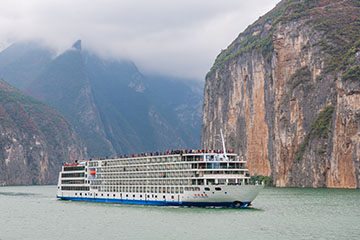Name in Chines: 湖北 Hú Běi [hubei]
Location: Central China, GMT+8
Population: 59.27 million
Keywords: the Three-Gorge Dam, Wu-Dung Tai Chi and Wuhan
Overview
Hubei is a land-locked province in Central China, bordering some Chinese provinces, namely, Anhui, Henan, Shanxi, Chongqing and Hunan. It is located in the middle reach of Yangtze River, covering an area of 185,900 square kilometers(71,776 sq.mi). The land is divided into 13 prefectures. Some of the popular holiday destinations are Wuhan, Yichang, Enshi, Shiyan, etc. The topography of Hubei can be read in summary as the mountainous region in the north and west, the hilly region in the east and the vast plain in the south. Hubei Province is noted for the Three-Gorge Dam and Wu-Dung Mountain. The former is the largest hydro power station in the world, is the main component of the Three-Gorge Water Conservancy Project. The latter is a holy land of Taoism, is the birthplace of Tai Chi Chuan. The province is the home to some Chinese ethnic groups, such as the Han, the Tujia and the Miao. Wuhan is the capital city of Hubei. On October 10th, 1911, an armed uprising against the Qing’s Government broke out. It brought about the collapse of the Qing Empire.
Attractions:
The Three-Gore Cruise
The Three Gorges have been an important navigable waterway for centuries. The waterway lies between Hubei Province and Chongqing. It is the most beautiful part of the Yangtze River. The gorges are Qutang Gorge, Wu Gorge and Xiling Gorge. The west mouth of the Three Gorges is called Kuimen or Qutangguan. It is the entrance to Qutang Gorge which is well-known for the magnificence of the scenery. Qutang Gorge is the shortest one of the three gorges with a length of 8 kilometers(5 miles). Wu Gorge is the middle section of the Three Gorges. It is 46 kilometers(29 miles) in length, is the most gorgeous one among the Three Gorges. Xiling Gorge is the east section of the Three Gorges, is 66 kilometers(41 miles) in length. It is the longest and most perilous one among the Three Gorges.
Wu-Dung Mountain
Wu-Dung Mountain is situated in Northwestern Hubei. The mountain is a holy land of Taoism, is the birthplace of Tai Chi Chuan. There are over a hundred Taoist temple in the mountain. The temples were added to the list of world cultural heritage sites by UNESCO in 1994. Tai Chi Chuan is also known as Chinese Shadow Boxing. It is an ancient Chinese "internal" or "soft" martial art often practised for its health-giving and spiritual benefits. The moves of Tai Chi are gentle and generally slow-paced. It helps to burn calories and improve one’s health.
The Yellow-Crane Tower
As the landmark of Wuhan, the Yellow-Crane Tower stands on the top of Sheshan Mountain, overlooking the Yangtze River. It is one of the top three old building in the Yangtze River Basin. The Tower was originally built in the year of 223 and reconstructed in 1985. It is a five-storey building with a height of 51.4 meters(169 feet).
Sanxiarenjia Fishing Village
Sanxiarenjia Fishing Village is located by the Yangtze River, about 35 kilometers(22 miles) to the northwest of downtown Yichang. It is a picturesque fishing village, is a national five-star scenic area. The locals lead a tranquil life in the village. They belong to Tujia Ethnic Group. The village shows the authentic Tujia’s traditional culture.
Climate
Hubei Province lies in the northern semi-tropical zone. Its climate is mainly influenced by the monsoons from Southwestern Pacific Ocean which bring rain to the land. The monsoon in Hubei lasts from June to July. The average temperature in Hubei Province ranges from 3℃(37.4°F) to13℃(55.4°F) in spring, 18℃(64.4°F) to 27℃(80.6°F) in summer, 24℃(75.2°F) to 33℃(91.4°F) in autumn, and 8℃(46.4°F) to 17℃(62.6°F) in winter. Both spring and autumn are the best time to travel to Hubei. The spring comes in February and goes in April, while the autumn lasts from September to November.
Local Specialties
The local food in Hubei is less spicy than that of Sichuan. Hubei people are good at cooking fish. One of their favourite dishes is Steamed Wuchang Fish. It is a kind of freshwater fish that only lives in the waters of Yangtze River. Some foreigners also call it the blunt-snout bream. The dish has a delicate flavour and a tender texture.
How to Get to Hubei
Wuhan is the capital city and aviation hub of Hubei Province. Wuhan Tianhe International Airport is located 27 kilometers(17 miles) to the city proper. Currently, it operates flights to 72 domestic cities and 47 overseas metropolises. The net work covers Europe, North America, Asia and Oceania, with linked destinations around the world, such as, Moscow, London, Rome, New York, San Francisco, Sydney, Melbourne, Singapore, Kulua Lumpur and Bangkok. Tourists can also travel to Wuhan by bullet train from Beijing, Shanghai and Guangzhou. More and more foreigners choose to go on a cruise along the Yangtze River from Chongqing or Yichang.
Author: Tina Luo
Update:

